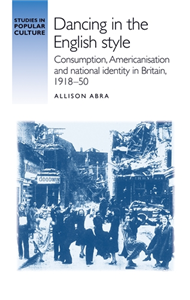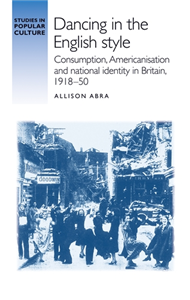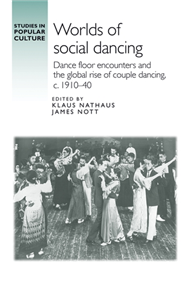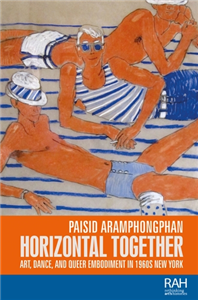Your Search Results
-
Promoted Content
-
Promoted ContentHumanities & Social SciencesApril 2017
Dancing in the English style
Consumption, Americanisation and national identity in Britain, 1918–50
by Allison Abra, Jeffrey Richards
-
 Trusted Partner
The ArtsNovember 2016
Trusted Partner
The ArtsNovember 2016Dance and politics
Moving beyond boundaries
by Dana Mills
This book examines the political power of dance, particularly its transgressive potential. Focusing on readings of dance pioneers Isadora Duncan and Martha Graham, Gumboots dancers in the gold mines of South Africa, the One Billion Rising movement, dabke in Palestine and dance as a protest against human rights abuse in Israel, it explores moments in which the form succeeds in transgressing politics as articulated in words. Close readings and critical analysis grounded in radical democratic theory combine to show how reading political dance as 'interruption' can unsettle conceptions of both politics and dance.
-
 Trusted Partner
HistoryApril 2017
Trusted Partner
HistoryApril 2017Dancing in the English style
Consumption, Americanisation, and national identity in Britain, 1918–50
by Allison Abra. Series edited by Jeffrey Richards
Dancing in the English style explores the development, experience, and cultural representation of popular dance in Britain from the end of the First World War to the early 1950s. It describes the rise of modern ballroom dancing as Britain's predominant popular style, as well as the opening of hundreds of affordable dancing schools and purpose-built dance halls. It focuses in particular on the relationship between the dance profession and dance hall industry and the consumers who formed the dancing public. Together these groups negotiated the creation of a 'national' dancing style, which constructed, circulated, and commodified ideas about national identity. At the same time, the book emphasizes the global, exploring the impact of international cultural products on national identity construction, the complexities of Americanisation, and Britain's place in a transnational system of production and consumption that forged the dances of the Jazz Age.
-
 Trusted Partner
Humanities & Social SciencesNovember 2016
Trusted Partner
Humanities & Social SciencesNovember 2016Dance and politics
Moving beyond boundaries
by Dana Mills
This book examines the political power of dance, particularly its transgressive potential. Focusing on readings of dance pioneers Isadora Duncan and Martha Graham, Gumboots dancers in the gold mines of South Africa, the One Billion Rising movement, dabke in Palestine and dance as a protest against human rights abuse in Israel, it explores moments in which the form succeeds in transgressing politics as articulated in words. Close readings and critical analysis grounded in radical democratic theory combine to show how reading political dance as 'interruption' can unsettle conceptions of both politics and dance.
-
 Trusted Partner
Humanities & Social SciencesNovember 2016
Trusted Partner
Humanities & Social SciencesNovember 2016Dance and politics
Moving beyond boundaries
by Dana Mills
This book examines the political power of dance, particularly its transgressive potential. Focusing on readings of dance pioneers Isadora Duncan and Martha Graham, Gumboots dancers in the gold mines of South Africa, the One Billion Rising movement, dabke in Palestine and dance as a protest against human rights abuse in Israel, it explores moments in which the form succeeds in transgressing politics as articulated in words. Close readings and critical analysis grounded in radical democratic theory combine to show how reading political dance as 'interruption' can unsettle conceptions of both politics and dance.
-
 Trusted Partner
Humanities & Social SciencesNovember 2016
Trusted Partner
Humanities & Social SciencesNovember 2016Dance and politics
Moving beyond boundaries
by Dana Mills
Introduction 1 Moving beyond boundaries: writing on the body 2 'I dreamed of a different dance': Isadora Duncan's danced revolution 3 'The body says what words cannot': Martha Graham, dance and politics 4 'I want to tell them how I feel and how black people feel': Gumboots dance in South Africa 5 Dancing the ruptured body: One Billion Rising, dance and gendered violence 6 Dancing human rights Conclusions: the dancer of the future dancing radical hope Index
-
 Trusted Partner
The ArtsMay 2021
Trusted Partner
The ArtsMay 2021Horizontal together
Art, dance, and queer embodiment in 1960s New York
by Paisid Aramphongphan, Amelia Jones, Marsha Meskimmon
Horizontal together tells the story of 1960s art and queer culture in New York through the overlapping circles of Andy Warhol, underground filmmaker Jack Smith and experimental dance star Fred Herko. Taking a pioneering approach to this intersecting cultural milieu, the book uses a unique methodology that draws on queer theory, dance studies and the analysis of movement, deportment and gesture to look anew at familiar artists and artworks, but also to bring to light queer artistic figures' key cultural contributions to the 1960s New York art world. Illustrated with rarely published images and written in clear and fluid prose, Horizontal together will appeal to specialists and general readers interested in the study of modern and contemporary art, dance and queer history.
-
 Trusted Partner
The ArtsMay 2021
Trusted Partner
The ArtsMay 2021Horizontal together
Art, dance, and queer embodiment in 1960s New York
by Paisid Aramphongphan, Amelia Jones, Marsha Meskimmon
Horizontal together tells the story of 1960s art and queer culture in New York through the overlapping circles of Andy Warhol, underground filmmaker Jack Smith and experimental dance star Fred Herko. Taking a pioneering approach to this intersecting cultural milieu, the book uses a unique methodology that draws on queer theory, dance studies and the analysis of movement, deportment and gesture to look anew at familiar artists and artworks, but also to bring to light queer artistic figures' key cultural contributions to the 1960s New York art world. Illustrated with rarely published images and written in clear and fluid prose, Horizontal together will appeal to specialists and general readers interested in the study of modern and contemporary art, dance and queer history.
-
 Trusted Partner
Humanities & Social SciencesMarch 2022
Trusted Partner
Humanities & Social SciencesMarch 2022Worlds of social dancing
Dance floor encounters and the global rise of couple dancing, c. 1910–40
by James Nott, Klaus Nathaus, Jeffrey Richards
By the 1920s, much of the world was 'dance mad,' as dancers from Buenos Aires to Tokyo, from Manchester to Johannesburg and from Chelyabinsk to Auckland, engaged in the Charleston, the foxtrot and a whole host of other fashionable dances. Worlds of social dancing examines how these dance cultures spread around the globe at this time and how they were altered to suit local tastes. As it looks at dance as a 'social world', the book explores the social and personal relationships established in encounters on dance floors on all continents. It also acknowledges the impact of radio and (sound) film as well as the contribution of dance teachers, musicians and other entertainment professionals to the making of the new dance culture.
-
 Trusted Partner
Humanities & Social SciencesMarch 2022
Trusted Partner
Humanities & Social SciencesMarch 2022Worlds of social dancing
Dance floor encounters and the global rise of couple dancing, c. 1910–40
by James Nott, Klaus Nathaus, Jeffrey Richards
By the 1920s, much of the world was 'dance mad,' as dancers from Buenos Aires to Tokyo, from Manchester to Johannesburg and from Chelyabinsk to Auckland, engaged in the Charleston, the foxtrot and a whole host of other fashionable dances. Worlds of social dancing examines how these dance cultures spread around the globe at this time and how they were altered to suit local tastes. As it looks at dance as a 'social world', the book explores the social and personal relationships established in encounters on dance floors on all continents. It also acknowledges the impact of radio and (sound) film as well as the contribution of dance teachers, musicians and other entertainment professionals to the making of the new dance culture.
-
 Trusted Partner
The ArtsDecember 2024
Trusted Partner
The ArtsDecember 2024Horizontal together
Art, dance, and queer embodiment in 1960s New York
by Paisid Aramphongphan
Horizontal together tells the story of 1960s art and queer culture in New York through the overlapping circles of Andy Warhol, underground filmmaker Jack Smith and experimental dance star Fred Herko. Taking a pioneering approach to this intersecting cultural milieu, the book uses a unique methodology that draws on queer theory, dance studies and the analysis of movement, deportment and gesture to look anew at familiar artists and artworks, but also to bring to light queer artistic figures' key cultural contributions to the 1960s New York art world. Illustrated with rarely published images and written in clear and fluid prose, Horizontal together will appeal to specialists and general readers interested in the study of modern and contemporary art, dance and queer history.
-
 Trusted Partner
Humanities & Social SciencesSeptember 2019
Trusted Partner
Humanities & Social SciencesSeptember 2019Dancing in the English style
Consumption, Americanisation and national identity in Britain, 1918–50
by Allison Abra, Jeffrey Richards
Dancing in the English style explores the development, experience, and cultural representation of popular dance in Britain from the end of the First World War to the early 1950s. It describes the rise of modern ballroom dancing as Britain's predominant popular style, as well as the opening of hundreds of affordable dancing schools and purpose-built dance halls. It focuses in particular on the relationship between the dance profession and dance hall industry and the consumers who formed the dancing public. Together these groups negotiated the creation of a 'national' dancing style, which constructed, circulated, and commodified ideas about national identity. At the same time, the book emphasizes the global, exploring the impact of international cultural products on national identity construction, the complexities of Americanisation, and Britain's place in a transnational system of production and consumption that forged the dances of the Jazz Age.
-
 Trusted Partner
Humanities & Social SciencesMarch 2022
Trusted Partner
Humanities & Social SciencesMarch 2022Worlds of social dancing
Dance floor encounters and the global rise of couple dancing, c. 1910–40
by James Nott, Klaus Nathaus, Jeffrey Richards
By the 1920s, much of the world was 'dance mad,' as dancers from Buenos Aires to Tokyo, from Manchester to Johannesburg and from Chelyabinsk to Auckland, engaged in the Charleston, the foxtrot and a whole host of other fashionable dances. Worlds of social dancing examines how these dance cultures spread around the globe at this time and how they were altered to suit local tastes. As it looks at dance as a 'social world', the book explores the social and personal relationships established in encounters on dance floors on all continents. It also acknowledges the impact of radio and (sound) film as well as the contribution of dance teachers, musicians and other entertainment professionals to the making of the new dance culture.
-
 Trusted Partner
The ArtsMay 2021
Trusted Partner
The ArtsMay 2021Horizontal together
Art, dance, and queer embodiment in 1960s New York
by Paisid Aramphongphan, Amelia Jones, Marsha Meskimmon
Horizontal together tells the story of 1960s art and queer culture in New York through the overlapping circles of Andy Warhol, underground filmmaker Jack Smith and experimental dance star Fred Herko. Taking a pioneering approach to this intersecting cultural milieu, the book uses a unique methodology that draws on queer theory, dance studies and the analysis of movement, deportment and gesture to look anew at familiar artists and artworks, but also to bring to light queer artistic figures' key cultural contributions to the 1960s New York art world. Illustrated with rarely published images and written in clear and fluid prose, Horizontal together will appeal to specialists and general readers interested in the study of modern and contemporary art, dance and queer history.


















